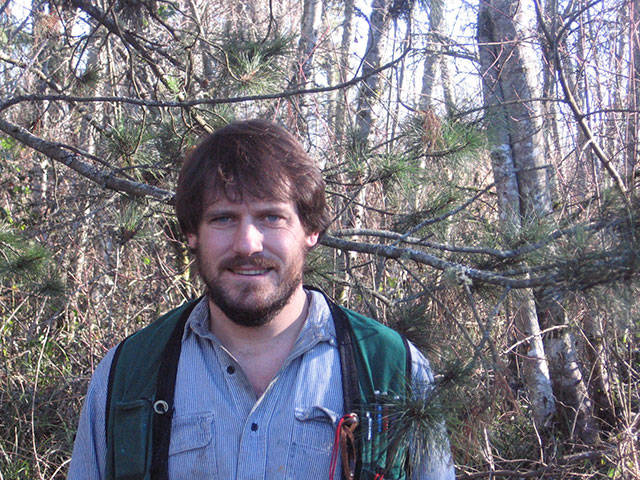The front page story in The Beachcomber last week, “King County forests are facing new challenges,” describes how climate change is exacerbating forest health problems created by past forest management, as well as creating new ones. As an islander and forester, I am writing this op-ed to discuss what islanders can do to help their forests adapt to a warmer and drier future. I will also correct some factual errors in the article to ensure readers have accurate information.
First, the most important action we can do for our forests is to dramatically and quickly reduce carbon emissions. Otherwise, the current projections for climate change will overwhelm our adaptation efforts and cause major, unpredictable changes to vegetation in our region.
In terms of Vashon’s forests, an estimated one-quarter of Vashon’s forests are mature, alder dominated forests that mostly originated from agricultural fields that were abandoned in the 1930s. These forests are at the end of their natural lifespans and are drought prone. To ensure they transition to forest and sequester lots of carbon, landowners can choose to harvest a portion of the alder and then replant, or replant as the alder dies. In either case, controlling shrub competition is necessary to ensure the replanted trees survive.
Managing for diverse forests with a significant component of broadleaf/hardwood trees species (big leaf maple, madrone, alder, willow, cottonwood, aspen, birch, Oregon white oak, etc.) is another critical climate adaption strategy. The article incorrectly suggested that broadleaf species are a problem and not a natural part of our forests. Mid-19th-century surveys from the Puget Sound region show that 3 to 20% of forests were broadleaf.
Broadleaf species provide important wildlife habitat, are mostly unaffected by insects and diseases that attack conifers, are more resistant to fire to windthrow than conifers and are very effective at establishing after disturbances. Forests with a mix of conifer and broadleaf species will be the most resilient to stressors that are increasing with climate change: drought, wind, insects and fire.
Planting drought-tolerant tree species is a third strategy. Douglas fir, madrone and big leaf maple are our most drought tolerant species. Western red cedar and western white pine are moderate, while western hemlock, Sitka spruce and alder are the most susceptible. White oak, lodgepole and ponderosa pine are very drought tolerant species that are rare on Vashon, but found in the region. Mixing in seedlings from drier regions or seed zones (e.g. Douglas fir from the Willamette Valley) with seedlings from this area is also recommended. While these seedlings may struggle early on, they may be better adapted to future climates. There is a great website covering this topic at seedlotselectiontool.org/sst. At this point in time, it is not recommended to plant non-native species.
Knowing your soil type and its soil moisture capacity will help determine what species to plant where. In general, gravelly and sandy soils (glacial outwash) hold less water. Finer textured, glacial till and lake sediment soils are better sites for species that need more moisture, especially when the soils are deep (about 2 or more feet). You can find maps of soils types on the USDA Soil Web website. In general, planting trees when a site is open (after a disturbance like clearing, root rot mortality, fire, etc.) will be more effective than planting underneath a tree canopy.
Denser forests are also more prone to drought stress. Thinning forests reduces competition for water and nutrients, and thus the remaining trees have more resources to withstand drought, insects, and root rot. Thinning also benefits wildlife habitat by increasing non-tree plant diversity and abundance. As described in the article, King County has thinned many of its dense 30-40-year-old Douglas-fir plantations, including those in Island Center and Dockton Forests.
Thinning older, dense conifer forests can also increase drought resistance. The article incorrectly stated that many forests on Vashon were planted with broadleaf species after World War II. In fact, almost all of Vashon’s forests were logged or cleared by the 1930s. Most of our conifer forests are 70-120 years old and established after early logging or land clearing and naturally reseeded. This sometimes led to dense forests dominated by Douglas-fir, which are more vulnerable to climate change than more diverse forests.
Increasing fire risk is another major area of concern that was raised in the article. It’s a complicated issue that I will address in a subsequent op-ed.
Climate change threatens many aspects of the natural world in the PNW, including our forests. Yet our forests are highly adapted to change. Provided that we reduce emissions quickly, many of the functions and values we get from our forests can be sustained with concerted action. Based on the current species, density, and soil type, you can assess how vulnerable your forest is and take appropriate action over time.
— Derek Churchill is a forest health scientist with the WA Department of Natural Resources and has a PhD in forest ecology and management from the University of Washington. He has lived on Vashon for 20 years and has worked extensively with the Vashon Forest Stewards and King County in Vashon’s public and private forests.



